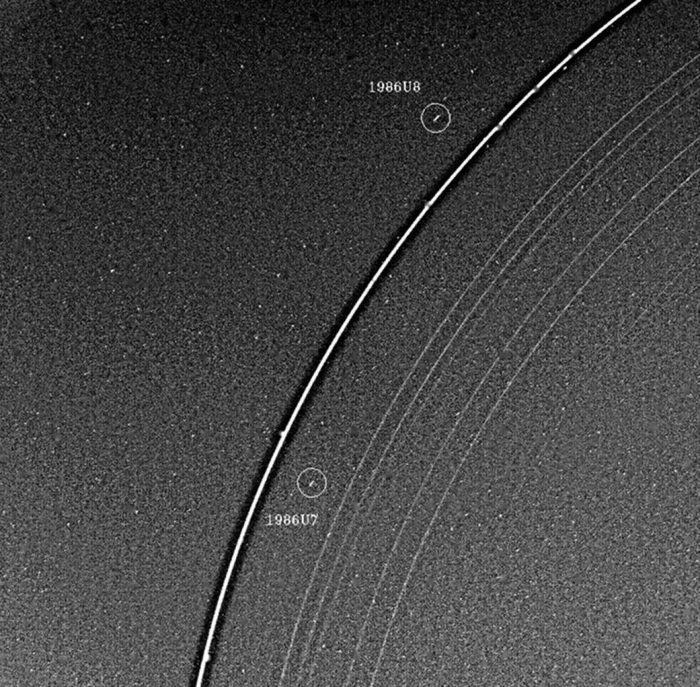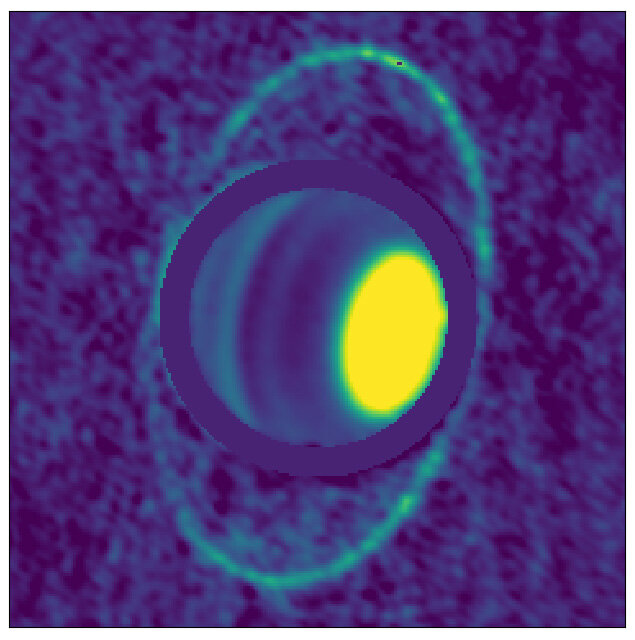Everyone knows that Saturn has rings. They're kind of hard to miss — they can even been seen from Earth with the most basic of telescopes. But Uranus' rings are not as well known. Or seen.
The biggest reason why? They're quite narrow for one. And they're also extremely dark.
Unlike with Saturn, Uranus' rings are made of particles that are charcoal-coloured. They absorb most of the light that hits them, reflecting almost nothing back to our eyes.
But as it turns out that doesn't mean that they can't still glow. You just need to be looking at them the proper way! New heat-based images of Uranus show the rings jumping out with surprising clarity. How does something so dark 'glow' like this?
A cool glow

Even in this enhanced image taken by Voyager 2, Uranus' rings are very hard to see. (NASA)
This image taken by Voyager 2 in 1986 had to be enhanced big time to get the rings to show up. You can see that they're essentially the same brightness as much of the other background 'noise' of open space in the background. As mentioned, this is because those rings absorb almost all the light that hits them.
But the thermal, or heat-based, image at the top of this post is different. Its images are based on temperature, not reflected light waves. This means that the warmth of the rings allows them to glow next to the planet!
The funniest thing about calling these rings warm? They're actually freezing. They measure just 77 Kelvin (K), or -196.15 °C/-321.07 °F! But when the coldest temperature on Uranus is about 47 K, then those rings are going to appear pretty warm in comparison!
What is Kelvin anyway?

The Kelvin scale was named for physicist, engineer, and all-around cool guy, Lord Kelvin. (Wikimedia Commons)
Okay, normally we'd end this post now, but because we're science geeks, we can't resist the chance to quickly talk about Kelvin. The Kelvin scale is an absolute temperature scale. This means that it moves only in one direction (unlike Celsius and Fahrenheit, which both have plus and minus temperature readings). One unit on this scale is called a Kelvin, or K.
So why do we use Kelvin to measure temperature in space? Well, take Celsius. 0 °C is the freezing point of water and 100 °C is water's boiling point. Celsius is a temperature scale that is made for life on Earth, a place where water is the abundant driving force of life. But in space, liquid water is ultra rare. There, you need a scale designed for the harsh realities of the universe.
That's Kelvin. Basically, it is scientifically impossible for anything to be colder than 0 Kelvin. That is absolute zero — the point where there is no movement of quantum particles at all. Incidentally, the coldest that open space can be is about 2.7 Kelvin. So now you know why Uranus' 77 Kelvin rings stand out there as being "warm"!
 Though still extremely cold, Uranus' rings are actually warmer than the average temperature of the planet they surround. (Edward Molter and Imke de Pater/UC Berkeley)
Though still extremely cold, Uranus' rings are actually warmer than the average temperature of the planet they surround. (Edward Molter and Imke de Pater/UC Berkeley)










What is the boiling temp of water in Kelvins?
I had no idea that the Kelvin scale even existed but I knew a sliver about Uranus’s rings 😀
What is the conversion from Celsius to kelvins?